Biology MCQ For NEET With Answers Principles Of Inheritance And Variation Miscellaneous
Question 1. Which of the following is true regarding human genetics?
- Most characters are controlled by one gene
- Human skin colour is controlled by more than two genes
- Same characters are not inherited according to Mendel’s law
- All of the above
Answer: 2. Human skin colour is controlled by more than two genes
All statements are correct. In human, most characters are controlled by one gene, but some characters like human skin colour is controlled by more than one gene. These characters are not inherited according to Mendel inheritance pattern.
Read And Learn More: NEET Biology Multiple Choice Question And Answers
Question 2. Match the following columns
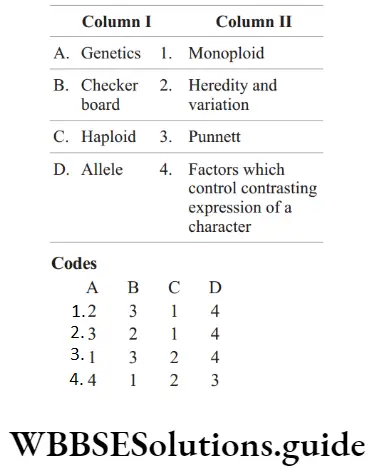
“pedigree analysis questions “
Answer: 1. A–2, B–3, C–1, D–4
Question 3. Assertion (A) Polytene chromosomes have a high amount of DNA. Reason (R) Polytene chromosomes are formed by repeated replication of chromosomal DNA without separation of chromatids.
- Both A and R are true and R is the correct explanation of A
- Both A and R are true, but R is not the correct explanation of A
- A is true, but R false
- Both A and R are false
Answer: 1. Both A and R are true and R is the correct explanation of A
Both A and R are true and R is the correct explanation of A. Polytene chromosomes are giant chromosomes. They begin as normal chromosomes, but through repeated rounds of DNA replication without any cell division (called endoreplication) or separation of chromatids, they become large, banded chromosomes having large amount of DNA.
Biology MCQ For NEET With Answers
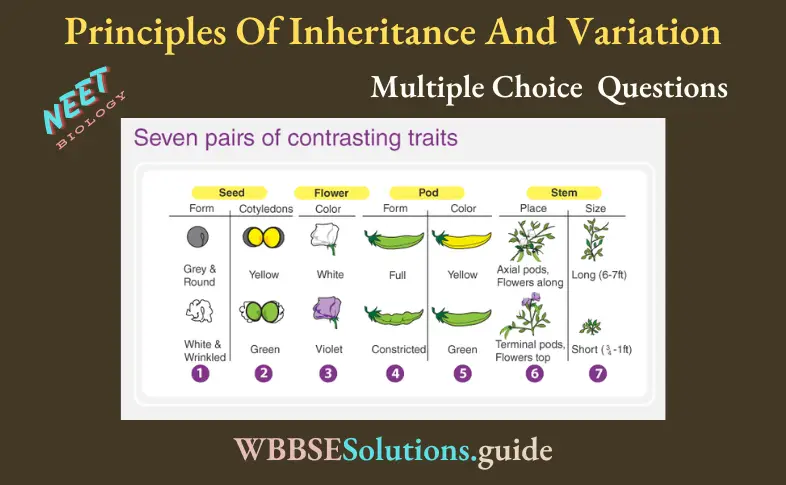
NEET Biology Principles of Inheritance and Variation MCQs with answers
Question 4. Which of the following match is correct?
- Independent assortment – Separation of factor
- Lamarck – Natural selection
- Hatch and Slack – Chemiosmotic theory
- Peter Mitchell – Proposed Z scheme
Answer: 1. Independent assortment – Separation of factor
- Option (1) is correctly matched. According to law of independent assortment, the two factors of each character assort or separate, independent of the factors of other characters at the time of gamete formation and get randomly rearranged in the offspring.
- Other options are incorrect and can be corrected as Darwin–Natural selection Peter Mitchell – Chemiosmotic theory Hatch and Slack –C 4 pathway
“principles of inheritance and variation pyq neet “
Question 5. Branching habit of sunflower plant is a …… character.
- Recessive
- Dominant
- Both 1 and 2
- None of these
Answer: 2. Dominant
- Branching habit of sunflower is a dominant character over unbranching habit. Single copy of gene of branched habit is sufficient to express itself.
- Since, the allele for branched habit can express itself in heterozygous condition, it is not a recessive character. When both recessive and dominant traits are expressed in a heterozygous genotype, it is codominance, but only branching habit of this plant is expressed in heterozygous condition.
Question 6. A plant with same genotype has different phenotype. Yes or No?
- No, because identical genotype give identical phenotype
- No, because of mutation
- Yes, due to environment affects on the phenotype
- Yes, because phenotype and genotype are depended on the area of growth
Answer: 3. Yes, due to environment affects on the phenotype
Environment can influence the phenotype of an organism due to which plant with same genotype can have different phenotype, e.g. human skin colour.
Question 7. Match the Column I with Column II and select the correct option.
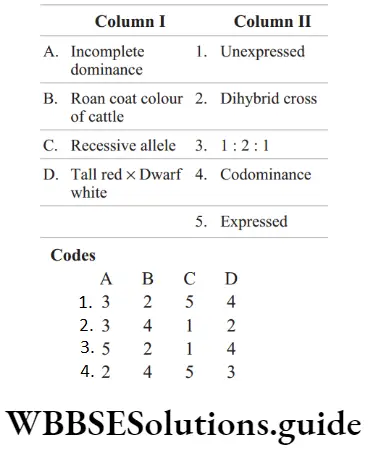
Answer: 2. A–3, B–4, C–1, D–2
Important MCQs on Principles of Inheritance and Variation for NEET
Question 8. Match the name of scientist given in Column I with the contribution given in Column II.
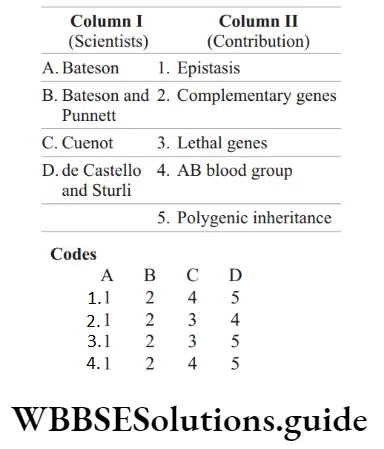
“inheritance and variation mcq “
Answer: 2. A–1, B–2, C–3, D–4
Question 9. A nutritionally wild type of organism, which does not require any additional growth supplement, is known as
- Phenotype
- Holotype
- Autotroph
- Prototroph
Answer: 4. Prototroph
- Prototroph is the nutritionally wild strain which is unable to grow in the minimal medium unless additional nutrients were added to the medium.
- Phenotype is the kind of organism produced by the reaction of a given genotype with the environment. Holotype is one of the original types used to describe a new species. Autotroph are organism who make their own food.
Biology MCQ For NEET With Answers
Question 10. Match the following columns.
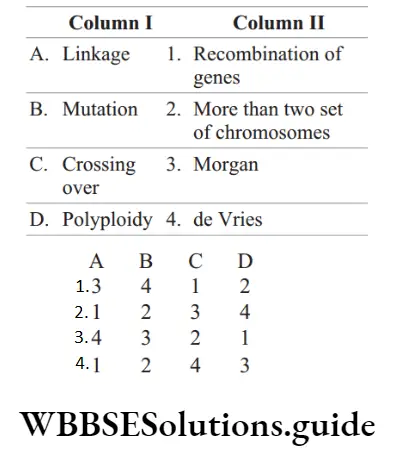
Answer: 1. A–3, B–4, C–1, D–2
Question 11. The number of genotypes produced when individual of genotype YyRrTt are crossed with each other?
- 4
- 64
- 28
- 27
Answer: 4. 27
- Number of genotypes produced when individuals of genotype ‘YyRrTt’ are crossed with each other is 27. The number of genotypes produced can be calculated by n × n × n, where ‘n’ is the number of alleles in the given genotype.
- In the given question, there are three types of alleles which shows that n = 3. Therefore, the number of genotypes produced when YyRrTt = 3 × 3 × 3 = 27.
“monohybrid test cross ratio “
Question 12. A normal, green male maize plant is crossed with albino female. The progeny is albino because
- Trait for albinism is dominant
- The albinos have biochemical to destroy plastids derived from green male
- Plastids are inherited from female parent
- Green plastids of male must have mutated
Answer: 3. Plastids are inherited from female parent
Besides nucleus, some genes are 3, 1, 2. also present in the cytoplasm of the female, parent and these genes are called plasmogens. In the given example, the progeny is albino because of inheritance of plastids from female parent.
Biology MCQs with answers for NEET
Question 13. What is the correct sequence of the following events?
- Formation of the chromosome theory of heredity.
- Experiments which proved that DNA is the hereditary material.
- Mendel’s laws of inheritance discovery.
Choose the correct answer
- 1, 3 and 2
- 1, 2 and 3
- 3, 1 and 2
- 2, 1 and 3
Answer: 3. 3, 1 and 2
- Correct sequence of statements are 3, 1 and 2. Mendelian inheritance is a type of biological inheritance that follows the principles originally proposed by Gregor Mendel in 1865 and 1866, re-discovered in 1900 and popularised by William Bateson.
- Chromosome Theory of Heredity was proposed in 1902. The HersheyChase experiments were a series of experiments conducted in 1952 by Alfred Hershey and Martha Chase that helped to confirm that DNA is genetic material. Thus, option (3) is correct.
NEET quiz on Inheritance and Variation with solutions
Question 14. One of the following is the correct statement.
- Mendel’s laws were not postulated by Mendel himself
- Mendel simply gave theortical and statistical explanation of his research work
- Correns represented the findings of Mendel into ‘laws of heredity’
- All of the above
Answer: 4. All of the above
All given statements are correct.
“monohybrid cross ratio “
Question 15. Preformation theory concerning transmission of characters was given by
- Swammerdam
- Aristotle
- Wolf
- Pythagoras
Answer: 1. Swammerdam
Preformation theory was proposed by two Dutch biologists, Swammerdam and Bonnet (1720-1793). This theory states that a miniature humen called homunculus was already present in the egg and sperm. In other words, a miniature human was preformed in the gametes.
Biology MCQs with answers for NEET
Question 16. ‘Law of filial regression’ was postulated by
- Mendel
- Morgan
- Watson and Crick
- Galton
Answer: 4. Galton
- Law of filial regression is the principle that inherited traits such as tallness may revert to the mean of the population meaning offspring would be tall, but closer to the population mean.
- Galton’s law of filial regression is another name for filial regression. Named after the English explorer and scientist Sir Francis Galton (1822–1911) who first drew attention to it.
Question 17. The phenomenon of ‘like begets like’ is due to
- Genetics
- Heredity
- Germplasm
- Variation
Answer: 2. Heredity
- The phenomenon of genetic transfer of characteristics from one generation to the next, where an offspring expresses characteristics similar to that of the parent is like begets like.
- This phenomenon is best understood when the offspring of a mango plant is a mango plant and that of a human is a human and not a monkey or a lion. So, the correct answer is heredity.
Question 18. Hypertrichosis is an example of which inheritance?
- Incomplete sex-linked
- Sex-limited
- Holandric
- Sex-influenced
Answer: 3. Holandric
Hypertrichosis is the excessive growth of hair on the body. It is an example of holandric inheritance. Genes responsible for this are located on Y-chromosomes only which are also known as holandric genes. Y-linked holandric genes are transmitted directly from father to son.
NEET Biology Mcq
Question 19. The longest chromosome is seen in
- Allium
- Lilium
- Trillium
- Zea mays
Answer: 3. Trillium
The size of chromosome is variable (0.25 – 30) and can be measured at metaphase during mitosis. The smallest chromosome is of 0.2 m observed in fungi and birds and the largest in some plant like Trillium (30).
Question 20. Match the following columns.
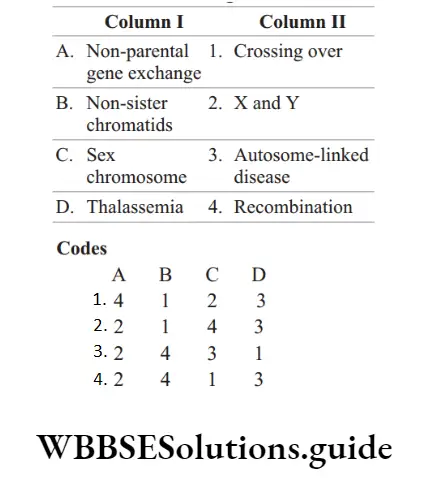
Answer: 1. A–4, B–1, C–2, D–3
NEET expected MCQs on Principles of Inheritance and Variation 2025
Question 21. Phenocopies have
- Different genotypes
- Different phenotypes
- Both of 1 and 2
- None of the above
Answer: 1. Different genotypes
“principles of inheritance and variation class 12 “
A phenocopy is a condition where the phenotype of an individual is altered because of an environmental factor and thus, the individual appears to have an altered genotype, though in
fact it does not.
NEET Biology Mcq
Question 22. Match the following columns.
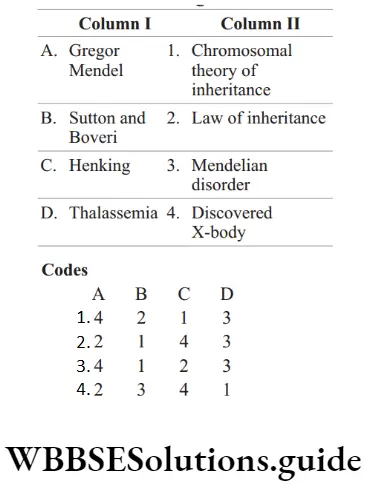
Answer: 2. A–2, B–1, C–4, D–3
Question 23. Match the following columns.
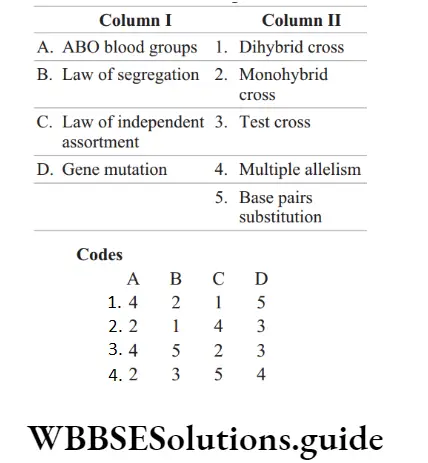
Answer: 1. A–4, B–2, C–1, D–5
NEET Biology Inheritance and Variation MCQs with explanations
Question 24. Which of the following is incorrectly paired?
- ‘SRY’ gene–X chromosome
- 2n–2–Nullisomic
- Nucleoid Prokaryote
- Polytene chromosome–Drosophila
- Trisomy–Down’s syndrome
Answer: 1. ‘SRY’ gene–X chromosome
Option (1) is incorrectly paired and can be corrected as ‘SRY’ is the sex reversal gene which is found on Y- chromosome. Rest all options are correct.
Question 25. Mixing of paternal and maternal chromosomes is called
- Amphimixis
- Mutation
- Apogamy
- Apomixis
Answer: 1. Amphimixis
A synonymous term for sexual reproduction is amphimixis. However, the more precise definition of amphimixis is the union or the fusion between the male and the female gametes in sexual reproduction.
